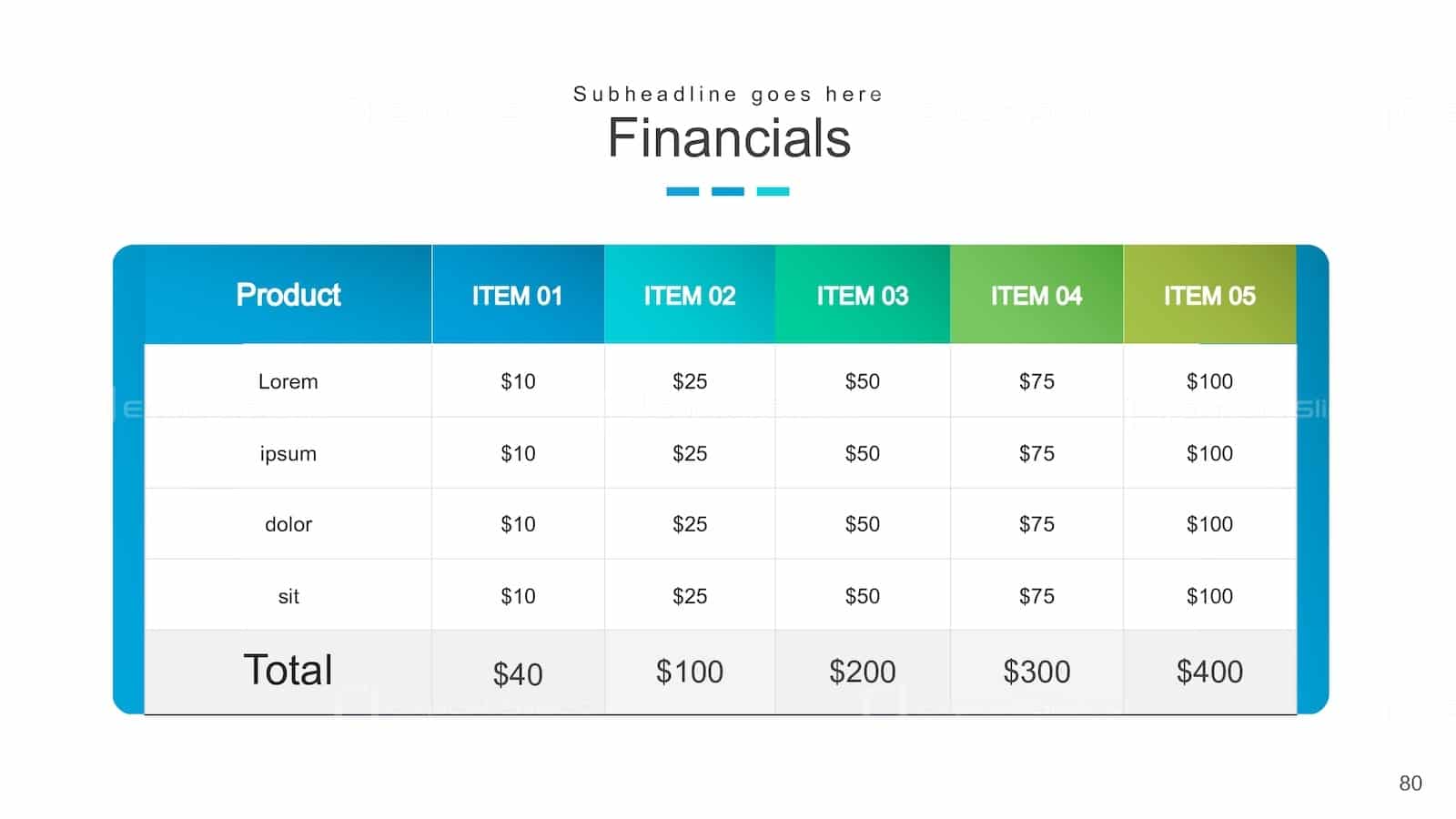Financial Presentation Template – Tips and Tricks for Success
Table of Contents
A financial presentation is a vital communication tool for businesses and organizations, enabling them to convey their financial performance, objectives, and strategies to stakeholders, investors, and other interested parties. This platform provides an opportunity to highlight the company’s financial stability, growth prospects, and investment opportunities, thereby fostering trust and confidence in its leadership and management. A well-structured financial presentation can also attract potential investors and partners, while demonstrating transparency and accountability in financial matters, which is crucial for maintaining a positive reputation and credibility in the market.
In addition, a financial presentation serves as an educational platform, informing the audience about the company’s financial position, market trends, and industry insights. It provides stakeholders with a clear understanding of the rationale behind financial decisions, investment plans, and future projections. By presenting a comprehensive and transparent financial picture, businesses can align stakeholders’ expectations and garner their support for future initiatives.
Ultimately, a financial presentation is a powerful tool for shaping perceptions, influencing decisions, and driving positive outcomes for the company.

Key Takeaways
- Understanding the importance of a financial presentation is crucial for effectively communicating financial information to stakeholders.
- Choosing the right template for your financial presentation can help create a professional and visually appealing presentation.
- Tips for creating a clear and engaging financial presentation include organizing information logically and using simple language.
- Incorporating visuals and data in your financial presentation can help illustrate key points and make complex information easier to understand.
- Structuring your financial presentation for maximum impact involves creating a compelling opening, clear main points, and a strong conclusion.
Choosing the Right Template for Your Financial Presentation
Key Considerations for Choosing a Template
When selecting a template for your financial presentation, it’s essential to consider the overall look and feel that aligns with your company’s branding and image. The template should be visually appealing, easy to read, and conducive to presenting complex financial information in a clear and organized manner.
Customization and Flexibility
A good template should be customizable to accommodate your specific content and data visualization needs. Look for templates that offer flexibility in terms of adding charts, graphs, tables, and other visual aids to enhance the presentation of financial data.
Compatibility and Audience Considerations
It’s crucial to ensure that the template is compatible with the software you will be using for creating and delivering the presentation. Additionally, consider the audience you will be presenting to and choose a template that resonates with their preferences and expectations. A well-chosen template can set the tone for your financial presentation and make a positive impression on your audience.
Tips for Creating a Clear and Engaging Financial Presentation
 When creating a financial presentation, it’s essential to focus on clarity, conciseness, and engagement to effectively communicate complex financial information. Start by defining the key messages and objectives of your presentation to guide the content creation process. Organize your content in a logical flow that takes the audience through the company’s financial performance, challenges, opportunities, and future outlook.
When creating a financial presentation, it’s essential to focus on clarity, conciseness, and engagement to effectively communicate complex financial information. Start by defining the key messages and objectives of your presentation to guide the content creation process. Organize your content in a logical flow that takes the audience through the company’s financial performance, challenges, opportunities, and future outlook.
Use simple language and avoid jargon or technical terms that may confuse or alienate non-financial audiences. Incorporate storytelling techniques to make your financial data relatable and compelling. Use real-life examples, case studies, or success stories to illustrate key points and connect with your audience on an emotional level.
Additionally, leverage the power of visuals to enhance the presentation of financial data. Use charts, graphs, infographics, and other visual aids to simplify complex information, highlight trends, and make data-driven insights more accessible and memorable. Lastly, engage your audience by encouraging participation through interactive elements such as polls, quizzes, or Q&A sessions.
By creating a clear and engaging financial presentation, you can effectively convey your message and leave a lasting impact on your audience.
Incorporating Visuals and Data in Your Financial Presentation
| Slide Number | Content | Tips and Tricks |
|---|---|---|
| 1 | Title Slide | Use a clear and concise title that captures the essence of your presentation |
| 2 | Agenda | Provide a roadmap of what will be covered in the presentation |
| 3 | Financial Goals | Clearly outline the financial objectives and targets |
| 4 | Financial Performance | Present key financial metrics and performance indicators |
| 5 | Financial Strategies | Explain the strategies and tactics to achieve financial goals |
| 6 | Financial Projections | Provide future financial projections and forecasts |
| 7 | Risks and Mitigations | Address potential risks and outline mitigation plans |
| 8 | Conclusion | Summarize key points and call to action |
Visuals and data play a crucial role in enhancing the effectiveness of a financial presentation by making complex information more accessible, understandable, and memorable. When incorporating visuals, consider using charts and graphs to illustrate key financial metrics, trends, and comparisons. Choose the right type of visual representation that best conveys the message you want to communicate, whether it’s a line chart for showing trends over time, a pie chart for illustrating proportions, or a bar graph for comparing different categories.
In addition to charts and graphs, consider using infographics to present complex financial data in a visually appealing and digestible format. Infographics can help simplify intricate concepts, processes, or relationships by using icons, illustrations, and minimal text to convey information more effectively. Furthermore, consider using images, icons, or illustrations to add visual interest and break up text-heavy slides.
Visual elements can help capture the audience’s attention, create a more engaging presentation experience, and reinforce key messages. When presenting data in your financial presentation, it’s important to ensure accuracy, relevance, and context. Provide clear labels, titles, and legends to help the audience understand the significance of the data being presented.
Avoid cluttering slides with too much data or overwhelming visuals that may distract from the main message. Instead, focus on highlighting the most important insights and trends that support your key points. By incorporating visuals and data effectively in your financial presentation, you can enhance comprehension, retention, and engagement among your audience.
Structuring Your Financial Presentation for Maximum Impact
 The structure of your financial presentation plays a critical role in guiding the audience through the content in a coherent and compelling manner. Start by creating an introduction that captures the audience’s attention and sets the stage for what they can expect from the presentation. Clearly state the purpose of the presentation, its relevance to the audience, and what they will gain from attending.
The structure of your financial presentation plays a critical role in guiding the audience through the content in a coherent and compelling manner. Start by creating an introduction that captures the audience’s attention and sets the stage for what they can expect from the presentation. Clearly state the purpose of the presentation, its relevance to the audience, and what they will gain from attending.
Provide an overview of the agenda to give the audience a roadmap of what will be covered throughout the presentation. Next, organize the main body of your presentation into logical sections that flow seamlessly from one topic to another. Consider structuring your content around key themes such as financial performance, market analysis, strategic initiatives, and future projections.
Use transition slides or verbal cues to signal when you are moving from one section to another to help maintain continuity and coherence. Within each section, present information in a clear and structured manner using headings, subheadings, bullet points, or numbered lists to guide the audience through the content. Finally, conclude your financial presentation with a strong summary that reinforces key takeaways and calls to action.
Recap the main points covered in the presentation and emphasize any actionable insights or decisions that need to be made. Leave the audience with a clear understanding of what they should do next or how they can further engage with the presented information. By structuring your financial presentation for maximum impact, you can effectively guide your audience through the content and leave a lasting impression.
Practicing and Rehearsing Your Financial Presentation
Mastering Your Content
To deliver a confident and polished financial presentation, it’s essential to start by familiarizing yourself with the content. Thoroughly review your slides and notes to ensure you have a deep understanding of the data, key messages, and supporting evidence or examples. This will help you feel more comfortable and confident when presenting.
Perfecting Your Delivery
Practice delivering your presentation out loud multiple times to get comfortable with the flow of information and timing. Consider recording yourself to review your delivery style, body language, vocal tone, and overall presence. Pay attention to areas where you may stumble or lose clarity, and make necessary adjustments.
Seeking Feedback and Fine-Tuning
Seek feedback from colleagues or mentors who can provide constructive criticism on areas for improvement or suggestions for enhancing your delivery. If possible, rehearse your presentation in front of a test audience to simulate real-life conditions and receive valuable input on how well your message resonates with different perspectives. Use this opportunity to fine-tune your delivery based on audience reactions and feedback. By practicing and rehearsing your financial presentation thoroughly, you can build confidence in your delivery style, ensure smooth execution on the day of the presentation, and maximize the impact of your message on your audience.
Handling Q&A and Follow-up in Your Financial Presentation
The Q&A session following your financial presentation provides an opportunity for further engagement with your audience and addressing any lingering questions or concerns they may have. It’s important to prepare for this segment by anticipating potential questions that may arise based on the content presented. Consider creating a list of common questions or concerns that stakeholders may have about your financial performance or strategic plans.
During the Q&A session, actively listen to each question being asked before responding thoughtfully and respectfully. If you don’t have an immediate answer to a question, it’s okay to acknowledge it and offer to follow up with more information at a later time. Be transparent about any limitations or uncertainties in your responses while demonstrating confidence in addressing inquiries within your expertise.
After the Q&A session concludes, consider providing additional resources or contact information for further follow-up inquiries from interested parties. This could include sharing relevant reports, data sources, or offering one-on-one meetings for more in-depth discussions. Follow up promptly with any outstanding questions or requests for information that may have arisen during or after the presentation.
By handling Q&A effectively and providing thorough follow-up support after your financial presentation, you can demonstrate responsiveness, credibility, and commitment to addressing stakeholder needs. This can further strengthen relationships with your audience and build trust in your ability to communicate openly and transparently about financial matters. In conclusion, creating an effective financial presentation requires careful planning, attention to detail, and strategic communication techniques.
By understanding the importance of a financial presentation as a tool for building trust, educating stakeholders, and shaping perceptions about your company’s financial performance, you can approach it with purposeful intent. Choosing the right template for your financial presentation sets the stage for creating a professional visual representation of complex financial data that resonates with your audience. Tips for creating a clear and engaging financial presentation emphasize the use of storytelling techniques, visual aids such as charts and infographics, as well as interactive elements to capture attention and convey key messages effectively.
Structuring your financial presentation for maximum impact involves creating an engaging introduction, organizing content into logical sections with seamless transitions, and delivering a strong conclusion that reinforces key takeaways. Practicing and rehearsing your financial presentation is essential for delivering a confident performance that resonates with your audience while handling Q&A effectively provides an opportunity for further engagement with stakeholders after the presentation concludes. By incorporating these tips and tricks into your financial presentations moving forward you can ensure that they are impactful engaging informative transparently communicated leaving lasting impressions on all those who attend them.
FAQs
What is a financial presentation template?
A financial presentation template is a pre-designed format for creating and delivering presentations related to financial information. It typically includes sections for financial data, analysis, and projections.
What are the benefits of using a financial presentation template?
Using a financial presentation template can help to streamline the process of creating a presentation, ensure a professional and consistent look, and save time by providing pre-designed slides for financial data, charts, and graphs.
What are some tips for success when using a financial presentation template?
Some tips for success when using a financial presentation template include customizing the template to fit the specific needs of the audience, using clear and concise language, and ensuring that all financial data is accurate and up-to-date.
What are some common mistakes to avoid when using a financial presentation template?
Common mistakes to avoid when using a financial presentation template include overcrowding slides with too much information, using overly complex charts or graphs, and failing to rehearse the presentation beforehand.
Where can I find a financial presentation template?
Financial presentation templates can be found on various online platforms, such as Microsoft Office, Google Slides, and professional presentation template websites. Many of these templates are available for free or for purchase.
Get 15+ Mio. PowerPoint Assets - FREE SIGN-UP

Sign up for free to our PowerPoint extension, ExpertSlides. Everything you need, directly in PowerPoint. No credit card required.
Main Menu
Knowledge base
Useful Links






